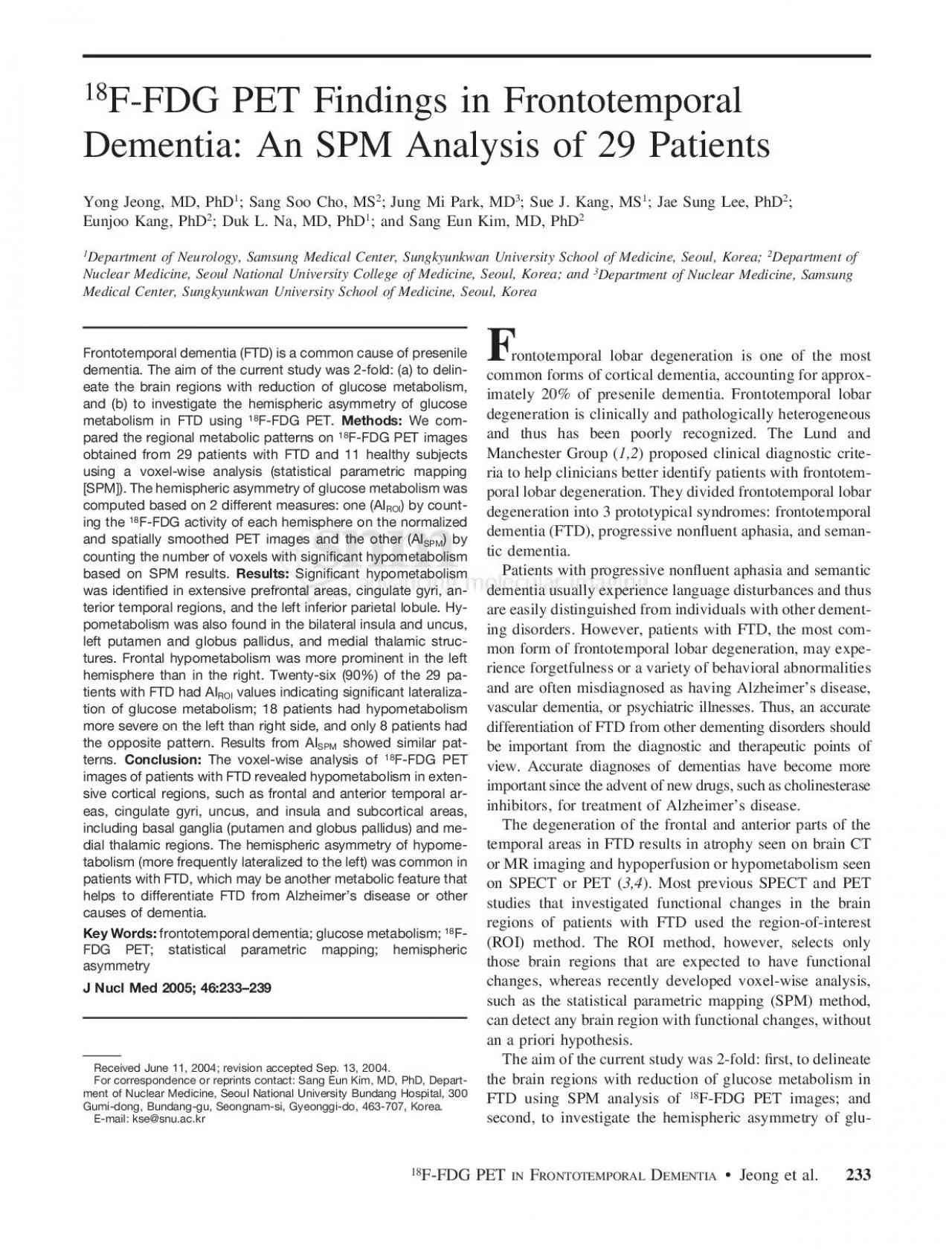

FrontotemporaldementiaFTDisacommoncauseofpreseniledementiaTheaimofthecurrentstudywas2foldatodelineatethebrainregionswithreductionofglucosemetabolismandbtoinvestigatethehemisphericasymmetryo ID: 955615
Download Pdf The PPT/PDF document "FFDGPETFindingsinFrontotemporalDementiaA..." is the property of its rightful owner. Permission is granted to download and print the materials on this web site for personal, non-commercial use only, and to display it on your personal computer provided you do not modify the materials and that you retain all copyright notices contained in the materials. By downloading content from our website, you accept the terms of this agreement.
F-FDGPETFindingsinFrontotemporalDementia:AnSPMAnalysisof29PatientsYongJeong,MD,PhD;SangSooCho,MS;JungMiPark,MD;SueJ.Kang,MS;JaeSungLee,PhDEunjooKang,PhD;DukL.Na,MD,PhD;andSangEunKim,MD,PhDDepartmentofNeurology,SamsungMedicalCenter,SungkyunkwanUniversitySchoolofMedicine,Seoul,Korea;Departmentof Frontotemporaldementia(FTD)isacommoncauseofpreseniledementia.Theaimofthecurrentstudywas2-fold:(a)todelin-eatethebrainregionswithreductionofglucosemetabolism,and(b)toinvestigatethehemisphericasymmetryofglucosemetabolisminFTDusingF-FDGPET.WecomparedtheregionalmetabolicpatternsonF-FDGPETimagesobtainedfrom29patientswithFTDand11healthysubjectsusingavoxel-wiseanalysis(statisticalparametricmapping[SPM]).Thehemisphericasymmetryofglucosemetabolismwas rontotemporallobardegenerationisoneofthemostcommonformsofcorticaldementia,accountingforapprox-imately20%ofpreseniledementia.Frontotemporallobardegenerationisclinicallyandpathologicallyheterogeneousandthushasbeenpoorlyrecognized.TheLundandManchesterGroup()proposedclinicaldiagnosticcrite-riatohelpcliniciansbetteridentifypatientswithfrontotem-porallobardegeneration.Theydividedfrontotemporallobar ReceivedJune11,2004;revisionacceptedSep.13,2004.Forcorrespondenceorreprintscontact:SangEunKim,MD,PhD,Depart-mentofNuclearMedicine,SeoulNationalUniversityBundangHospital,300Gumi-dong,Bundang-gu,Seongnam-si,Gyeonggi-do,463-707,Korea.E-mail:kse@snu.ac.krF-FDGPET¥Jeongetal. cosemetabolisminFTD,whichhasnotbeensystematicallyMATERIALSANDMETHODSBetweenJanuary1995andMay2002,64patientswerediag-nosedwithfrontotemporallobardegenerationatthehospitalwherethisstudywasconducted,accordingtotheconsensusclinicaldiagnosticcriteria().Thisgroupincluded40patientswithFTD,9withFTDplusmotorneurondisease,7withprogressivenon-ßuentaphasia,and8withsemanticdementia.Ofthe40patientswithFTD,29patientswhohadundergoneF-FDGPETscanswereincludedinthisstudy.AllpatientsfulÞlledtheconsensusclinicaldiagnosticcriteriaforFTD().ForcomparisonwithFTDpatients,PETscanswerealsoobtainedin11age-andsex-matchedhealthyindividuals.ThesehealthycontrolshadnohistoryofneurologicorpsychiatricillnessesandnospeciÞcabnormalitiesonneurologicandneuropsychologicexaminations.CharacteristicsofpatientandcontrolgroupsarepresentedinTable1.PatientsÕonsetsymptomsandmainsymptomsattheinitialvisitaredescribedinTable2.Allpatientsshowedearlylossofpersonalandsocialawareness,executivedysfunctions,abulicfeatures,andstereo-typedorcompulsivebehaviors.PETImagingPETscansof30minwereacquiredstarting40minafterintravenousinjectionof4.8MBq/kgF-FDGusinganAdvancePETscanner(GEHealthcare).In-pl
aneandaxialresolutionofthescannerwere4.9and3.9mmfullwidthathalfmaximum(FWHM),respectively.Subjectsfastedforatleast4hbeforePETimaging.PETimageswerereconstructedusingaHanningÞlter(cutofffrequency4.5mm)anddisplayedina128128matrix(pixelsize1.95mm,withaslicethicknessof4.25mm).AttenuationcorrectionwasperformedwithauniformattenuationcoefÞcient(0.096cmPETDataAnalysisSPMAnalysisofRegionalGlucoseMetabolism.Beforestatis-ticalanalysis,usingSPM99(WellcomeDepartmentofCognitiveNeurology,InstituteofNeurology,UniversityCollegeLondon)implantedinaMatlab5.3environment(MathWorks,Inc.),allimageswerepreprocessedforspatialnormalizationintotheMon-trealNeurologicalInstitute(MNI)templatetoremoveintersubjectanatomicvariability,thensmoothedwithaFWHM16-mmGauss-iankerneltoincreasethesignal-to-noiseratioandtoaccountforsubtlevariationsinanatomicstructures().Thecountofeachvoxelwasnormalizedtotheaveragecountofcerebellumusingacustomizedprogram,becausecerebellumisknowntobeoneoftheleastaffectedregionsinFTD.ImagesofpatientswithFTDwerecomparedwiththoseofhealthycontrolsinavoxel-wisemannerusingSPM99bothforbetween-groupanalysisandforindividual-to-groupanalysis(0.001,uncorrected;extentthreshold,200).Forthegroupanalysis,a2-sampletestwasusedtodetectdifferencesbetweentheFTDandhealthycontrolgroups.Fortheindividualanalyses,a2-sampletestwasperformedforeachpatient,sothateachpatientas1group(1)wascomparedwiththesamehealthycontrolgroup(11).Forthegroupanalysis,2differentstatisticalcriteriawereused:0.01(Tcorrectedformultiplecomparison(extentthreshold,50);and0.0005(T6.29),corrected(extentthreshold,50).Eveniftheformerstatisticalcriterion(0.01,corrected)wasstrin-gentenoughforimagingresearch,areaswithsigniÞcantgroupdifferencesinthecurrentstudywerefartooextensivetoidentifyandlocalizethepeakcoordinatesforeachbrainregion.Therefore,weappliedanadditionalcriterionthatwasmorestringent(0.0005,corrected).Fordisplay,greenwasusedforthelowerthreshold(T5.18)andredforthehigherthreshold(T(Fig.1).However,thetableoflocalmaxima(Table3)wascomposedbasedonthelowerthreshold.Forvisualizationofthe-scorestatistics(SPM{}map),signif-icantvoxelswereprojectedontothe3-dimensionalrenderedbrainorastandardhigh-resolutionMRimagetemplateprovidedbySPM99,thusallowinganatomicidentiÞcation.TheMNIcoordi-natesofthelocalmaximumofeachclusterwereconvertedintoTalairachcoordinates()andlistedinTable3inbold,alongwithT-valuesandclustersizes.Foraclusterthatcontainedextensiveareas,thecoordinatesofitslocalsubmaximawerealsolistedinthetableinaregularfont.AnalysisofHemisphericAsymmetryofGlucoseMetabolism.evaluatethehemispherica
symmetryofglucosemetabolisminFTD,weobtainedasymmetryindices(AIs)ofmetabolismbetweenthehemispheresusingROIandSPManalysesofF-FDGPETimagesineachpatientwithFTD.FromthepreprocessedPETimages,includingcerebellarnormalizationF-FDGactivityofcerebellum50)asdescribedpreviously,theaverageF-FDGactivityofeachhemispherewascountedusingtheROImethodandanAIbetweenthehemisphereswascomputedusingthefollowingequation:F-FDGactivityoflefthemisphereF-FDGactivityofrighthemisphere)/(averageactivityoflefthemisphereF-FDGactivityofright200.Thebrain-maskimagegiveninSPMTABLE1CharacteristicsofthePatientandControlGroups Age(y)DiseasedurationPatients59.210.710192.51.114.9Controls61.95.747Ñ29.1 Mini-MentalStateExamination.Valuesaremean OURNALOF¥Vol.46¥No.2¥February2005 softwarewasdividedintotheleftandrighthemispheresac-cordingtothe-coordinateofeachvoxeltodeÞnetheROIs.OnanSPM{}mapofeachpatient,thenumberofvoxelswithsigniÞcant(0.001,uncorrected)hypometabolismcomparedwiththehealthycontrolgroupwascountedineachhemisphere,andanAIbetweenthehemisphereswascalculatedusingthefollowingequation:AI(numberofhypometabolicvoxelsinrighthemispherenumberofhypometabolicvoxelsinlefthemisphere)/(numberofhypometabolicvoxelsinrighthemi-numberofhypometabolicvoxelsinlefthemi-200.PositiveAIandAIvaluesindicatethattherighthemisphereismorehypometabolic(intermsofextentand/orintensity)thanthelefthemisphere;negativevaluesin-dicatetheopposite.TABLE2ClinicalCharacteristicsofPatients (y)Sex(y)Onsetsymptoms/mainsymptomsatinitialexaminationscoreGroup*179M4NamingdifÞculty/hoarding,wandering,excessiveeating,indifferenttopersonalhygiene.23L261F2Forgetfulness/shamelessness,urinaryincontinence,reducedspontaneousspeech,unabletostaystillinoneplace,easilydistracted,stupeÞed.16R359M2.5NamingdifÞculty/stubbornness,hoarding,decreasedspontaneousspeech,abusivelanguage,easilyirritated,overeats,tendencytogooutside,organizingobjectsinastraightline.12L470F3Causeanestrangementamongfamilymembers/overeats,usesabusivelanguage,lies,excessivelaughing,wastingmoney,becomeslazy,wandersabout.18R550F1Buyanunknownkidasoft-drinkeveryday/increasedstubbornness,reducedspontaneousspeech,unabletoÞnishatask,becamelazy,dull-witted,notexchangegreetings,overeats.23R668F3Memoryimpairment,decreasedverbaloutput/walksupanddownrestlesslyalldaylong,frequentlylaughs,touchesobjectsaroundher,doesnotspeakunlessspokento.740F2Doubtofhusband/unabletocontrolemotions,abusivelanguage,becameshameless,namingdifÞculty,urinaryincontinence,tendencytourinateanywhere,undressesherselfonthestreets.858F3Inappropriateinvestment/caressesotherpeopleÕsfaces,
repeatsthesamequestions,excessivelaughing,dull-witted,stubborn,stealsobject,wastesmoney.24L952F3Indifferenttohousework/wandersaboutinthehouse,goestothebathroomtoooften,compulsivelyreadswordsorsentencesonTV,frequentlaughing,reducedspontaneousspeech.1058M2.5Smokesacigarettebutt/urinatesanywhere,shamelessanddull-witted,quarrelswithcustomers(runsashop),becamelazy,stubborn,excessivelyfrugal,takesremainingfoodfromweddingceremonies,overeating,wandersaboutthehouse.24B1165F2Increasedstubbornness/lackinginjudgment,stubborn,becameaggressive,becameverbose,obsessiveaboutmoney,abusivelanguage,thoughtlessremarks,laughstoooften.1266F2Steals/stinginess,asksherrelativesformoney,overeats,excessivelaughing,hidesherdaughterÕsunderwearinherdrawers,insertshiscandyinapasserbyÕsmouth,hugsastranger.23L1358F2Characterchange,inappropriatejudgment/dull-witted,likesfreegifts,becamelazy,overeats,wandersarounddowntownallday.28R1451M3Decreasedverbaloutput/Þngersobjects,goesinandoutofthebathroomfrequently,tendencytogooutside,decreaseofspontaneousspeech,overeats.1562F4Impairmentinverbalexpression/mistrustofothers,object-namingdifÞculty,comprehensiondeÞcit,indifferenttoothers,lossofinterest,obsessedwithonetask.NAL1651M4Didnotattendsocialmeeting/overeats,frequentlyirritated,indifferent,inappropriatelaughing,wandersaboutinthehouse,roamsoutside,unabletostayinoneplace,easilydistracted.27L1753M3Indifferenttofamilymembers/doesnottalktoothers,tellsjokestostrangewomen,collisionaccidentwhiledriving,inappropriatelaughing,wanderingoutsidealldaylong.22R1841M1Nervoustonephews/reducedspeech,avoidssteppingonlinewhilewalking,becamegenerous,likessweets,becamestubborn,frequentvisitstothebathroom.12L1966F1Talksandlaughsloudlyinpublicplaces/overeats,violent,impatient,wanderingoutside.20L2073F4Opensandclosesdoorsfrequently,fumblesbothhands/becamegenerous,smilesfrequently,progressivereductionofspeech,urinaryincontinence.2141F5Indifferenttohousework/apathy,indifference,carelesshousekeeping,urinaryincontinence.23B2241M1Decreasedverbaloutputandinappropriatejudgment/repetitivebehaviors,abusivelanguage,depressivemood.18B2355F1.5NamingdifÞculty/namingdeÞcit,laughsawaymistakes,comprehensiondeÞcit,increased2463F3Becomefastidious/laughsoften,stubborn,wandering,decreasedspontaneousspeech,reducedabilitytoconcentrate.NAL2558M4Memoryimpairment/shortutterances,easilyfrustrated,dull-witted,shameless,stealsobjects,decreasedconcentrationability,becamestubborn,overeats,wandersalldaylong.14R2676F1.5NamingdifÞculty/lossofinterest,becamelazy,reducedspontaneousspeech.18L2760F1Verbalexpressioni
mpairment/reducedspontaneousspeech,lossofinterest,depressivemood.26L2857M2Repeatsameword/comprehensiondifÞculty,excessivepurchaseofcheapobjects,excessivepurchaseoflotterytickets,stubborn,indifferent,apathy.16L2974F1Forgetfulness/Þngeringobjects,readseverythingshesees,decreasedspontaneousspeech,urinaryincontinence.25R *AccordingtoAI,individualpatientswereclassiÞedintoeitherleft-dominant(hypometabolismmoresevereinthelefthemisphere)(L),right-dominant(R),orbilateralgroup(B).Mini-MentalStateExamination;NAnotavailable. F-FDGPET¥Jeongetal. StatisticalAnalysisDataareexpressedasmeanSD.AdifferencebetweenunpaireddatawasanalyzedbyanunpairedStudenttest.Corre-lationbetweenAIandAIwasevaluatedbycalculatingthePearsonlinearcorrelationcoefÞcient.ExceptforSPManalysis,0.05wasconsideredsigniÞcant.RegionalGlucoseMetabolismonF-FDGPETImagingFigure1andTable3showthebrainregionswithreducedglucosemetabolisminpatientswithFTDcomparedwiththehealthycontrolgroup.Withaheightthresholdof(correctedformultiplecomparison,T5.18),therewassigniÞcanthypometabolisminextensiveprefrontalareas,includingsuperior,middle,andinferiorfrontalgyriaswellasorbitofrontalandmedialfrontalareasandtheentirecingulategyri.MetabolismwassigniÞcantlyreducedinthebilateralanterior/ventraltemporalregions,leftinferiorpa-rietallobule,andrightcerebellartonsil.Hypometabolismwasalsofoundinthebilateralinsulaanduncusandsub-corticalstructures,includingleftputamenandglobuspalli-dus.Therewasalsohypometabolisminthedorsomedialthalamus,hypothalamicregion,andpulvinar.Withastrin-gentstatisticalcriterion(0.0005;corrected,Thypometabolismwasmoreprominentintheleftprefrontalareasthanintheright.ResultsofindividualanalysesareshowninFigure2.Althoughhypometabolicareaswerevariableamongpatients,allpatientsshoweddecreasedme-tabolisminthefrontaland/oranteriortemporalregions.HemisphericAsymmetryofGlucoseMetabolismFigure3showsthedistributionofAIandAIinpatientswithFTD.TheabsoluteAIwassigniÞcantlyhigherinpatientswithFTD(8.74.5)thaninhealthycontrols(2.61.1)(0.001).HemisphericasymmetryofglucosemetabolismwasconsideredtobepresentiftheabsoluteAIvaluewasgreaterthantheupperlimitofthe95%conÞdenceintervalofvaluesobtainedfromthecontrolgroupwhichwasmorethan3.4.Withthiscriterion,26(90%)ofthe29FTDpatientshadasymmetricmetabolism(Table2);18patientshadhypometabolismmoresevereinthelefthemisphere(leftdominant),and8patientshadhypometabolismmoresevereintherighthemisphere(rightdominant).Themean(SD)absoluteAIvalueinpatientswithFTDwas116.957.2.UsingAI,24(83%)ofthe29FTDpatientshadasymmetricmetabolism,inthattheabsoluteAIvaluesofthesepatien
tswerelargerthan50;15wereleftdominant,and9wererightdominant.ThiswassimilartotheresultfromAI.TherewasasigniÞcantcorrelationbetweenAIandAIF-FDGPETstudiesofFTDhavebeenreported).Mostoftheseinvestigatedtheregionalbrainme-tabolismusingvisualratingorROImethods(OnlyonestudyusedSPManalysis,butthisresearchin-cludedonlyasmallnumberofpatients(6)andtheseincludedpatientswithcombinedmotorneurondisease(OurSPManalysisofF-FDGPETimagesofpatientswithFTDshowedwidespreadareasofdecreasedmetabolisminvolvingbilateralprefrontalareas,includingdorsolateralfrontal,orbitofrontalandmedialfrontalareas,andanterior/ventraltemporalregions,asexpected.Hypometabolismwasalsofoundintheleftinferiorparietallobule,bilateralinsulaanduncus,andsubcorticalstructures,includingleftbasalgangliaandbilateralthalami.TheseÞndingsreplicatetheresultsofpreviousimagingorpathologicstudiesWefoundadditionalhypometabolicbrainregionsthathavenotbeenreportedinpriorstudies.Theseareasweretheinsulaanduncus.Theinsula,withitsconnectionwithcerebralcortex,basalganglia,thalamus,andlimbicstruc-turessuchasamygdalaandentorhinalcortex,isknowntobeinvolvedinavarietyofbrainactivities,includingso- FIGURE1.HypometabolicregionsinpatientswithFTDcom-paredwithhealthycontrols.Theseregionsaredisplayedonsurface-rendered(top)andtransaxial(bottom)images.Hypo-metabolicregionsweredisplayedaccordingto2differentthresholdsingreen(0.01;corrected,T5.18)andred(0.0005;corrected,T6.29).Numberineachtransaxialbrainimageindicatesdistance(mm)fromanteriorcommisureÐposte-riorcommisureplane.OURNALOF¥Vol.46¥No.2¥February2005 matosensory,swallowing,gustatory,vestibular,cardiovas-cular,andlanguagefunctions().Ithasalsobeenreportedthatdamagetotheinsulaproducessubjectivefeelingsofanergia,underactivity,andtiredness().Thus,itmaybepossiblethatinsularlesionsinourpatientsmaypartlycontributetosuchsymptomsaslackofenergyandreducedspeechandactivities.Also,theinsulaisoneofthebrainstructuresinvolvedinanetworkrecruitedduringmemorytesting.Itsactivitylevelmayshowacompensatorychangewithaginginhealthyoldindividuals().FailureofthiscompensatorychangemaybeassociatedwithcognitiveimpairmentinpatientswithFTD.NofunctionalimagingstudieshavereportedinsularinvolvementinFTD.Rosenetal.()reportedanatrophyoftheinsulainFTDusingvoxel-basedmorphometryofMRimages.Theysuggestedthepossibilityofarolefortheinsulainsocialbehavior.Hypometabolismintheuncusmaybeassociatedwithadysfunctionintheamygdala.Theamygdalahasstronglinkswithemotionalprocessing.Removaloftheamygdalaandsurroundingstructuresresultedinprofoundsocialdistur-bancesinprimates().Also,theuncusisapartofbrainr
egionsreportedtobeinvolvedinemotionalexpressionandvisualprocessingofemotions().MetabolicimpairmentoftheuncusasrevealedinthisstudymaybeassociatedwithdisturbancesinemotionalprocessingandsocialbehaviorinpatientswithFTD.Ithasbeensuggestedthatasymmetrichemisphericde-generationiscommoninpatientswithFTD(11,2022However,nosystematicanalysishasbeenperformed.Fur-thermore,thosestudiesincludedpatientswithprogressivenonßuentaphasiaandsemanticdementia,whichareknowntopreferentiallyaffectthelefthemisphere.WeevaluatedthehemisphericasymmetryofmetabolismonlyinpatientswithFTD.Wefoundthathemisphericmetabolicasymmetrywascommon(90%)andintenseinFTD,evenafterpatientswithprogressivenonßuentaphasiaandsemanticdementiawereexcluded.Thus,itcanbesuggestedthatFTDisadisorderthatcausesanasymmetricdegenerationofcerebralhemispheres.AccordingtoourdeÞnition,29patientswithFTDrecruitedinthisstudywereclassiÞedintoleft-domi-nant(hypometabolismmoresevereinthelefthemisphere;18),right-dominant(8),orbilateralgroups(TheclinicalsigniÞcanceofthemetabolicasymmetryisunknown.Theright-dominantgroupappearedtobeheter-ogeneousinclinicalmanifestations.Ontheotherhand,patientswhopresentedwithnamingdifÞculty(patients1,3,23,and26)orhadnamingdifÞcultyatinitialexamination(patient15)allbelongedtotheleft-dominantgroup.ThiscorrelationdoesnotseemtobespeciÞc,however,becausealargeportionoftheleft-dominantgroup(13/18)didnothavesuchlanguagedisturbanceÐpredominantproÞles.Thereasonfortheoverrepresentationoftheleft-dominantgroupremainsspeculative.OnepossibleexplanationisthatFTDmaypreferentiallyaffectthelefthemisphere.Apathologystudydemonstratedgreaterleft-thanright-sidedatrophicchangesinmostcasesofFTD().Alternatively,thismaybecausedbyasamplingbias.Left-dominantpatientscanshowlanguagedisturbanceseveninearlystages.Thus,itismorelikelythatthesepatientsarebroughttoneurologyclinics.Ontheotherhand,right-dominantpatientsmayTABLE3HypometabolicRegionsinPatientswithFTD RegionBAStereotaxiccoordinatesxyzLSuperiorfrontalgyrus8,9,101824509.6433,577LDorsomedialfrontalgyrus8428508.78LInferiorfrontalgyrus/insula47,44381949.59LSuperiortemporalgyrus/uncus382416267.61LGlobuspallidus/putamen204107.17RInferiorprefrontalgyrus44,474413255.25RInsula421746.33RUncus/inferiortemporalregion20,28384377.62MSuperiorprefrontalgyrus10455128.69MRectalgyrus11834226.84MHypothalamus98.07MAnteriorcingulategyrus24,23215297.81MPosteriorcingulategyrus31220296.46MThalamus21967.90BPulvinar2956.95LInferiorparietallobule4058436.08800RCerebellum42386.89336 *Voxelsize2mm.Brodmannarea;MHeightthreshold:T5.18(0.01,corrected). F-FDGPET¥Jeon